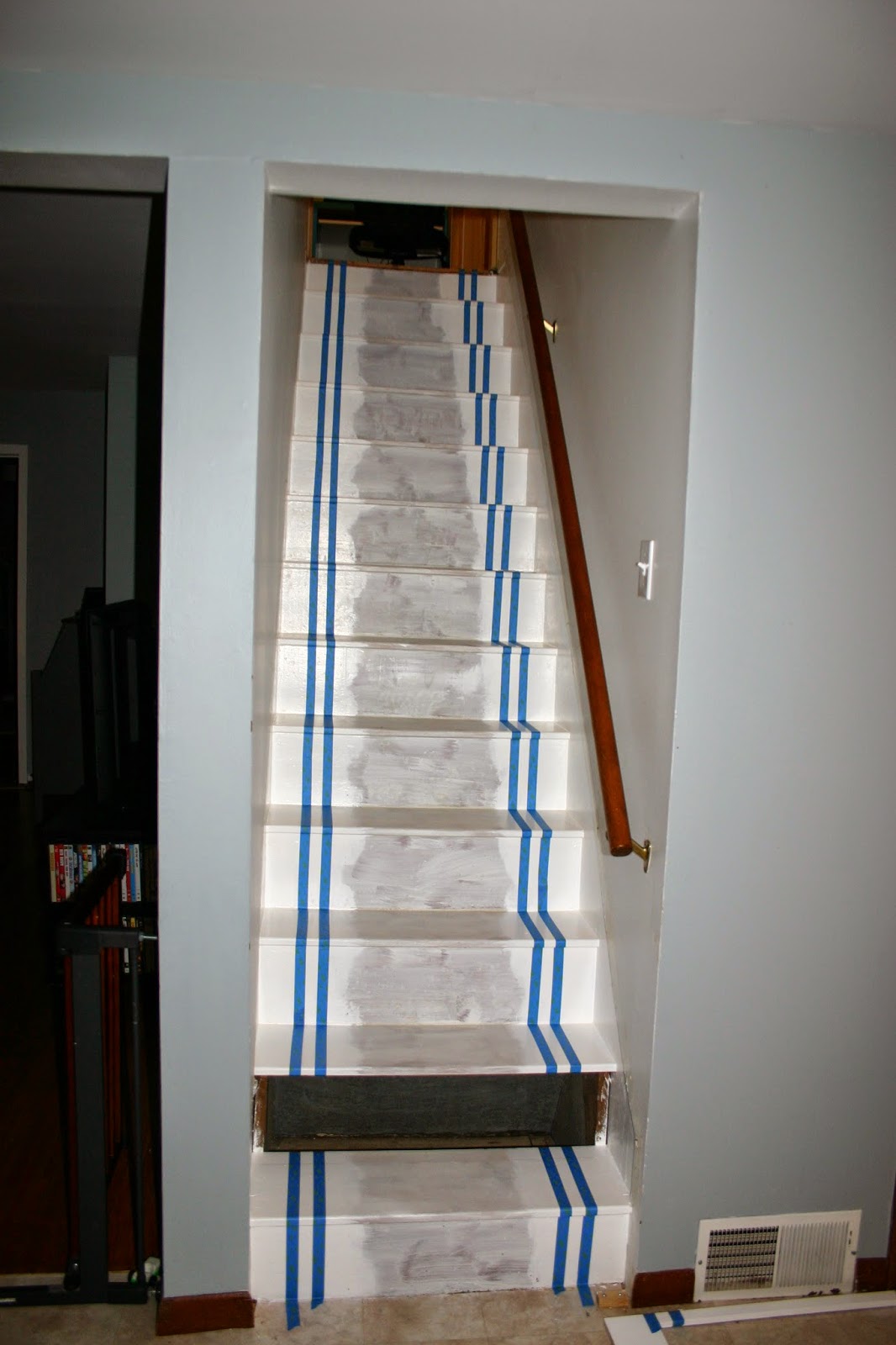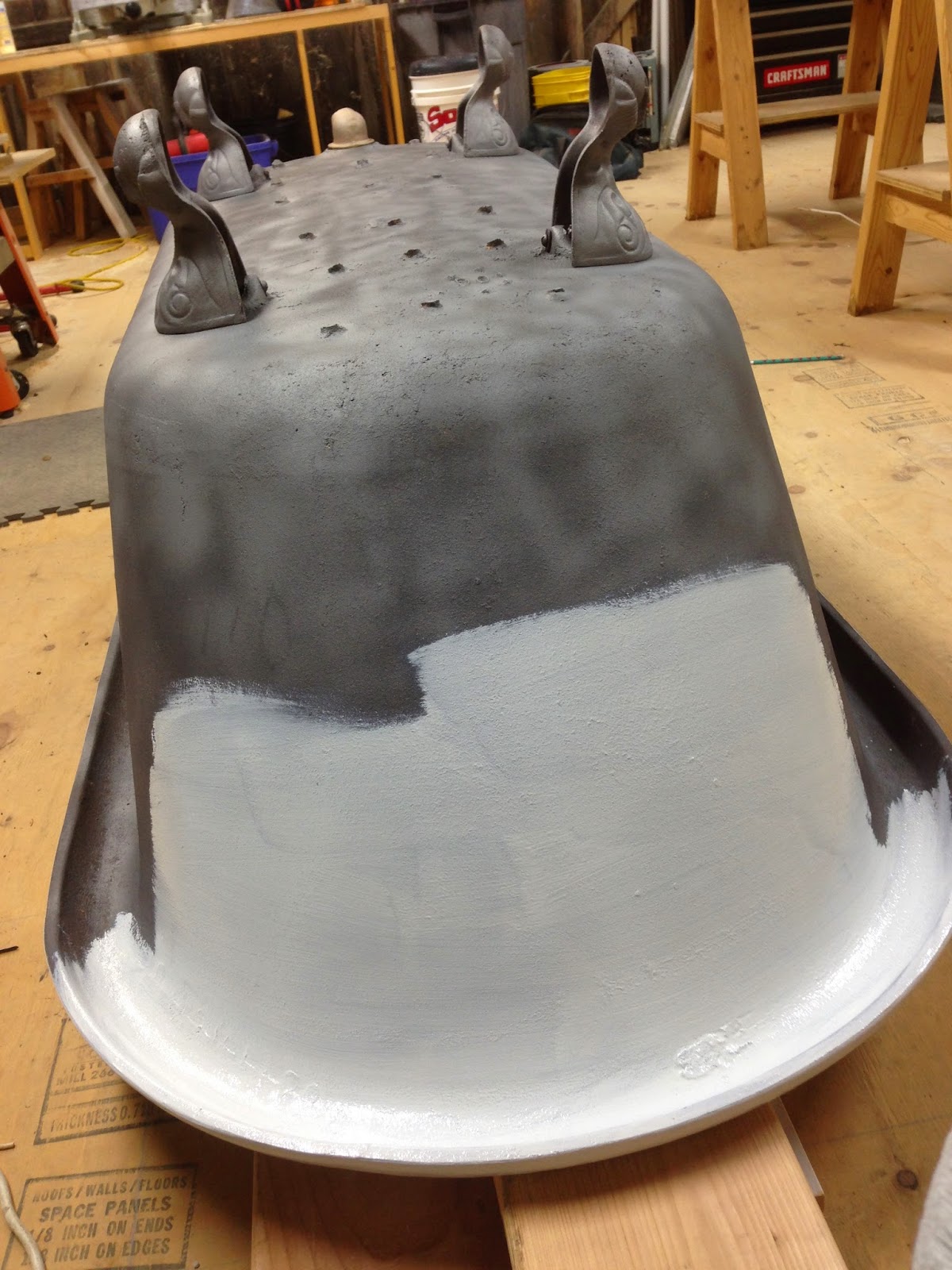Since we moved into our house just over 2 years ago, the stairs leading from the kitchen to the second story have looked like this:
They were carpeted (with a really ugly carpet) and to make matters worse, the carpet went up the sides of the walls, like a carpet fungus. While tearing out carpet is usually one of the first projects we tackle, we waited on this one because we had no idea what the stairs would look like under it and had the issue of the carpet climbing up the walls to deal with.
In typical Megan and Andy fashion, though, we finished up the project we were currently working on earlier than we expected on our weekend. With nothing else better to do, Andy decided that it was THE day to deal with the stairs. We investigated the stairs from the underside (looking up from the basement stairs) and determined that the stairs were likely made from pine and looked in pretty good shape. Andy felt pretty confident, so face clad in dust mask and tools in hand, he made quick work of tearing the carpet off the stairs.
There was a little padding on the stairs that also had to come up.
Left were thousands of staples and carpet tack- the torture tool hated most by home owners.
Andy used his favorite tools- a crowbar, pliers and hammer to take up the carpet tack and staples.
Once the stairs were unveiled we were thrilled to see they were in good shape. They are banged up as one would expect in an old house but definitely salvageable.
Thankfully there was drywall under the carpeted sections that went up the walls so this turned out to be as simple as pulling the trim off, pulling the carpet and removing staples.
 |
| Death by staple removal |
Another worry we had prior to tearing out the carpet was whether the stairs would be more or less treacherous without carpet. The stairs are clearly left from days when the upstairs was merely an attic so they are narrow and slightly steep. We couldn't live with the current carpet though, so we decided to take it off planning on painting the stairs but prepared with some back up runner ideas to attach if the stairs felt too slippery. The first day or two of bare stairs was a bit nervousing (totally made up word) but once we got used to not feeling carpet, we both felt confident on the bare stairs so we continue with Plan A- painting the stairs.
We have been amused how many projects we have done in this home that have mirrored projects we completed in our first home and this definitely follows the pattern. Our home in DeKalb, Illinois had a converted attic staircase with a carpet runner which we tore out and replaced with a hand painted runner.
 |
| DeKalb stairs- Risers and rail are brown, outside of tread is light blue and middle of tread is navy blue |
Before I could get to painting, Andy had to replace the grate on the riser of the second stair. The grate was screwed to the face of the riser and would easily get caught by shoes and bend out of shape. Andy took apart the adjoining tread and rebuilt the runner, installing a grate on the backside so it wouldn't get caught as people went up and down the stairs.
 |
| We picked out this decorative grate from Amazon |
The riser is removable in case we need to get to the duct work underneath.
I wanted to do something different in this house so I hit the internet and Pinterest. I am really good at executing other people's ideas but rarely can think of something completely on my own. After lots of searching, I found the perfect,
simple design from paintedtherapy.blogspot.com. If you check out the link, you will notice that I pretty much copied the design, down to the colors exactly. Often times there is no reason to reinvent the wheel.
Andy filled in major holes and sanded down the stairs to prep them for paint.
After a really good dusting and cleaning, I coated the entire staircase and wall where there was carpet with Zinsser 1, 2, 3 white primer.
The hardest and most time consuming part with painting a staircase is timing it and planning around foot traffic. I started at the top and worked my way down one night after we were sure the kids were asleep. Thankfully, the primer dried super fast.
Next, came the white border. Since the middle of the stairs would be blue, I just painted the wall sections and outside sections of staircase in true white paint/primer in semi-gloss. Again, I worked top down and did one coat during nap time since we would still carefully walk up the middle and a second coat that night.
On to the mathematical portion of the project. To make things simple, I went to the store and choose a painting tape in the same width that I wanted my skinny stripes. I taped out a few options- mostly looking at how wide I wanted the middle section in blue. I ultimately decided I wanted that to be pretty wide to look like a traditional rug runner. The stair width is 30" so I decided to have 18" of blue down the middle followed with 1" of white on both sides, followed by 1" of blue on both sides and finished with 4" of white.
 |
| Not at all to scale but the general idea |
Using a ruler and pencil, I marked a line at each break of color at the top and bottom of every tread/riser.
I then used 1" blue painters tape to mark the areas I would be painting blue.
This was where buying the correct width of tape came in handy because I was able to use one width of tape between the skinny blue stripe and the large blue runner. Right now, I will say that I used the wrong tape. Though I bought the nice and expensive blue painters tape, it wasn't very sturdy and kept ripping. It was much easier to keep a straight line if I rolled out the tape in a continuous strip all the way down the stairs. Also, a little preview as to what's to come, the blue tape did not do a very good job of keeping the paint from bleeding under the tape. After further research, I think frog tape might have done a better job in the end.

Once I had my lines taped out, I used Behr's Blue-Grey Slate paint/primer in eggshell (the same as on our bedroom walls). Had I bought paint specifically for this project, I probably would have made the mistake of buying semi-gloss, which is a better finish for high traffic areas like floors. This would have turned out to be a mistake, though because the gloss would have shown the imperfections of the stairs a lot more than a more matte paint. I did two coats of blue paint, going from the top to the bottom of the stairs.
After the stairs were dry, I slowly removed the tape for the big reveal and, damn. Some bleeding on the tape lines.
To fix this, I broke out one of Esther's paintbrushes and did touch up with the white paint. Again, I think using frog tape would have helped with this issue.
To prevent the stairs from chipping due to frequent foot traffic, Andy used a wipe-on clear polyurethane. This turned out to be a huge disaster. First off, it wouldn't dry despite the can's stated dry time so the morning after application, the kids came down leaving sock prints all the way down the stairs. Secondly, after a week or so the polyurethane began to yellow at the corners. This has never happened to us and I still have no idea why this happened.
After several months of thinking, "oh, we need to fix this...", Andy finally got around to sanding the stairs and applying a traditional brushed-on polyurethane in satin (again, we didn't want anything too glossy since that would show the imperfections of the wood even more). It actually turned out pretty good that we waited so long because dragging construction materials up and down the stairs for our bathroom remodel created several chips in the paint that we were able to touch up once the polyurethane was sanded off.
Andy reinstalled the trim work and I primed and painted it all white. Finally, the rail was primed and then painted the same color as the stairs.
Since I used paint that was around the house, the only things we needed to buy for this project were the painters tape, polyurethane and the new grate so the total for this project was under $20! Best 20 bucks I've spent in a while! Just refer back to the picture of the original stairs covered in a carpet fungus if you don't believe me.









.jpg)